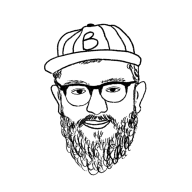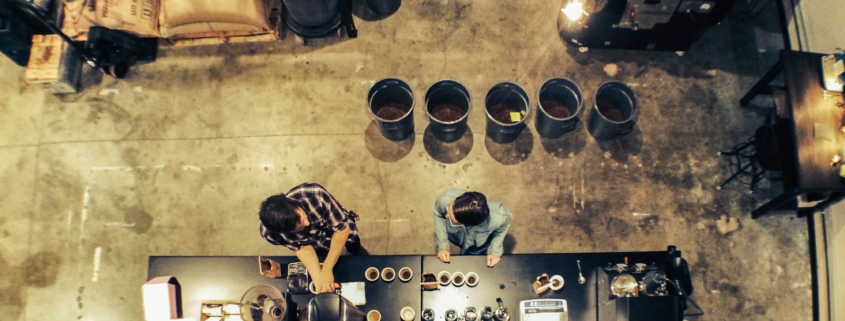Seed to Cup
My job is as a roaster and green buyer for a coffee company. I roast the coffee but I also source the green (unroasted) coffee beans (technically green coffee is a seed and not a legume), and so it’s my job to taste samples and figure out what roast profiles work best for each specific origin or blend. It’s a fun job at times, and incredibly monotonous at others. For a while, I worked by myself: I would “cup” the coffee—the process of evaluating a coffee based on objective and measurable standards—and then come up with the profile.
To cup coffee, you measure a small amount of freshly roasted whole beans, say 11 grams or so, and grind them in a few bowls to smell and taste. You first cup or evaluate the coffee based on its dry fragrance just after grinding and before you brew the coffee. Then you cup for aroma, which is how the coffee smells once it interacts with hot water. Finally, you take your fancy tasting spoon and slurp the coffee to aerate across your palate and taste for balance, acidity, sweetness, body, and overall consistency.
As a “professional,” I mostly know what I’m doing. What coffees I like and what aspects I like about various regions and varietals, and what I think works well in our coffee lineup for the season. It is a job easily managed by one person. However, as our company grew and we added staff, I realized the additional benefits of cupping, tasting, and evaluating coffee as part of a team are much more holistic. To hear other people’s critiques helps me create and curate coffee origins and roast profiles that are more diverse and complex than when I do it in a room by myself.
Around the same time, I realized the principle also applies to art and writing.
For many years I thought of writing as a solitary, purely individualistic endeavor. In my mind, I saw Hemingway and Fitzgerald, Woolf and Wallace typing away in dark rooms somewhere, their eyes half-glazed with a mixture of genius and insanity. This was my picture of a writer. A lone artist hammering away at the page in a Parisian bar, a café, or a New York apartment, isolated.
The process of writing is, after all, a solitary endeavor. You do not sit around in the park with a group of friends and write together like it’s a card game. You do not write with others the same way you dance or make music. You sit by yourself and try to come up with words.
But the next steps of writing (and arguably the most important) are rewriting and editing. And these steps are best done within a community.
Contrary to my desire to be a genius artist all on my own, I need others to help me make art. While I wish I were the person who is 100% autonomous and brilliant, the truth is that everything decent I’ve ever done is better when vetted by others. Sometimes it’s my wife or my family. Sometimes it’s a close friend or fellow artist. Sometimes it’s my colleagues on a journal, such as the one you’re currently reading. Often times, the best writing and art seems to come out of a collective where artists and writers are in constant dialogue with the world and others in their community.
What I didn’t understand as a young writer (though I am still a young writer) was that succeeding in the world of published and professional writers is not so much based on your own individual genius but your engagement in the literary community. Everyone belongs to a particular niche, genre, cohort, time-period, or community that fuses them and hones their craft. Finding a community helps you learn what particular niches grab you, what you like, and how to learn objectively from pieces you don’t subjectively “like.” You read works by classmates and friends, in journals, from editors, by agents. All artists—whether they be comedian, writer, painter, dancer, or musician—are generally part of a larger group.
There might be reclusive or solitary examples like J.D. Salinger or Emily Dickinson, but in general, works of art or ideas are often created in cultures or pods of community: Ginsberg, Kerouac, and Sandburg of the Beat poets, for instance, traveled together and wrote about each other in their New York and San Francisco communities. Hemingway, Fitzgerald, Picasso, and Stein loosely collaborated as ex-pats in Paris. James Baldwin and William Styron exchanged letters while they each wrote books dealing with race in the South. Jonathan Franzen and David Foster Wallace had a close relationship. Martin Scorsese and Robert de Niro have made nine movies together so far and garnered multiple Oscar nominations/wins. Each of these pairs or triplets or groups complement each another, even if they were not editing and critiquing each others’ work directly. Sometimes its just a sort of mysterious collective consciousness.
Collaboration breeds creativity.
So when I get an article published, though the byline may say written by Levi Rogers, what it really means is written by Levi and Lauren, David, Mike, Alex, Katelyn, Mary, Lyndsay, and Nick. Because while it may be “me” sitting alone at a coffee shop in Park City at this particular moment, the piece didn’t start solely with “me” and it won’t end with “me.” All of them will be involved.
Just like coffee is a complex undertaking that passes through multiple hands including farmers, importers, green buyers, roasters, and baristas, until the coffee seed becomes a brewed cup, so it is with writing.

Levi Rogers is a writer and coffee roaster out of Salt Lake City, UT. He lives with his wife Cat, his dog Amelie, and his many socks, all of which have holes. He’s currently an MFA candidate at Antioch University Los Angeles.





